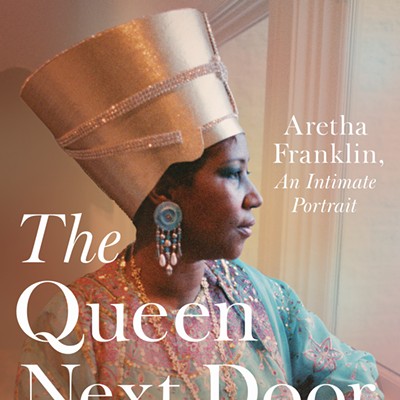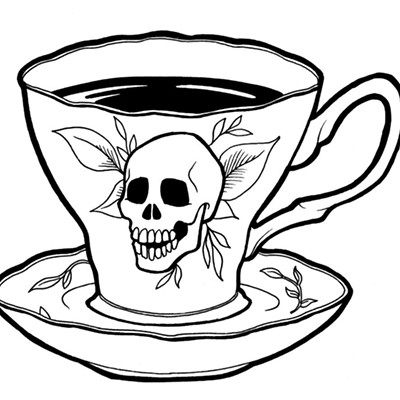On an overcast day in 2011, in the flatlands west of the Chiricahuas, a little girl climbed into a paddock.
Ashley Riggs may have been small and young, but it was up to her to paint the mark of her family's Crossed J Ranch onto the back of a calf. Her face intent, her fair hair flying in the wind, Ashley took a brush and traced the family J onto the animal's rough hide.
Scott T. Baxter recorded the moment in black and white, and the photograph of a little girl preserving a tradition is among 100 of his images now at the Tucson Museum of Art. Marking Arizona's centennial of statehood, his traveling exhibition, 100 Years 100 Ranchers, celebrates families who have been ranching in the state for at least a century. The Riggs family, we learn, has been on the land since 1879.
Phoenix photog Baxter spent 10 years off and on traveling Arizona to photograph old-time ranching families who still lead what the exhibition text calls a "fading way of life." Baxter nevertheless delights in creating pictures that demonstrate its continuity. He pictures mothers with daughters, grandfathers with grandsons, uncles with nephews, implying photographically that a new generation is ready to follow the old.
Katie Meyer Cline of the Flying UW Ranch near Winkelman grins broadly at the camera in a 2006 photo; in her arms is her wiggly baby, Sarah, whose smile is almost as wide as her mother's. (The Clines are among many women and girls making a welcome appearance in the show.) Demonstrating their loyalty to the life, they pose in front of a splintery wooden barn studded with horseshoes, deer antlers and a cow skull. And Katie herself is duded out cowgirl-style, with a checked shirt, jeans and a 10-gallon hat. If the future of ranching rested on this radiant pair, it could hardly be in doubt.
Wayne Klump of Cochise County is another happy rancher. In a lovely 2004 portrait, he sports a gray handlebar moustache, white cowboy hat, jeans and work boots. He's pretzeled his lanky frame into a metal chair, and sits in the shade beneath the sheltering branches of a tree. Behind him, the sun-washed Dos Cabezas Mountains slant upward toward the sky. Content with his land and his place in it, he smiles. But he's not the only Klump who loves the ranch the family has worked since 1904. It was here, in this beautiful spot, that his daughter chose to be married.
The landscape is as much of a character in this exhibition as any of its gangly cowboys awkwardly posing for the camera, with hands in their pockets and aw-shucks looks on their faces. The wide sweeps of land, the mountains jutting up on the horizon and the skies veering from sun to storm would make any city slicker want to hop on a horse and ride the range. Who wouldn't trade places with Marilyn Michelbach Coy, a rancher standing among sun-dappled aspens near Northern Arizona's San Francisco Peaks?
Baxter made a conscious choice to use old-fashioned black-and-white film, the better to evoke his subjects' historical nature. (Among the storied Arizona families he photographs are the Udalls and Ronstadts.) Some images are monumental in size, as big as 4 by 5 feet, and most are beautifully composed and sharply detailed, with strong lines and lights skillfully alternating with darks.
He moves easily from the extreme close-up portrait—don't miss the extraordinary wrinkled face of Connie Brown, an apparently ancient rancher in Gila County—to lonesome sky pictures with small figures dwarfed by the vast landscape, like the one of Jim Riggs, also of the Crossed J. A small, solitary figure in a grassy plain, he leans all of his body into the task of shutting a stubborn gate.
In fact, some of the best photos are of cowboys and cowgirls at work. At the Sierra Bonita Ranch near Willcox, Baxter caught Jesse Hooker Davis during the spring roundup. A cigarette clenched between his teeth and a branding iron clutched in his hand, Davis is at the center of a trio of men wrestling a calf down. The other two cowboys are down and dirty in the dust, and Davis towers over them, looming large above the low horizon in the distance, his hat thrust high up against the sky.
Oddly enough, for a self-consciously historical show, there's a static quality to the images, with few hints of change over time. I can't remember any pickups or ATVs, the range riders of choice for today's cowboys. No telephone wires mar the pristine landscape; nor do satellite dishes or trailers. There's no discussion of the environmental impact of grazing on a fragile, arid land. And only a few images hint at the troubles of this sometimes-contested terrain.
A melancholy 2011 photo of the remaining Krentz men on their Cochise County ranch is a reminder of the murder of Rob Krentz in 2010. His shooting, in a corridor frequented by undocumented migrants and drug-smugglers, is still unsolved.
In a 2011 picture from Santa Cruz County, one of the most beautiful in the show, Henry Amado poses with his son, Greg, and grandson, Matt, at Hacienda Amado. Framed by the branches of a gorgeous sycamore, the picture is meant to spell continuity. The middle generation has gone modern—Greg wears a baseball cap and jeans. But the grandson, sitting on a horse, wears the classic cowboy hat and chaps. He's reverted to the past, emulating his grandfather.
A note from Baxter reveals that the Amados have been ranching this land since about 1851, when it was abundantly peopled by Mexican ranchers. A few years later, the Gadsden Purchase of 1853-1854 converted Southern Arizona into U.S. territory. Though the Amados evidently held on to their ranch, many families of Mexican heritage were not so lucky; they lost title to their lands and were displaced.
As the museum's show upstairs (Tucson Collects: Spirit of the West) reminds us, American Indians also once occupied this terrain. Cochise County, location of many of the ranches Baxter photographed, was once the homeland of the Chiricahua Apaches. Defeated in 1886, they were torn from their beloved mountains and canyons and sent into exile.
Ashley Riggs, the young painter of calves, is far removed from this troublesome history of the place she inhabits. And she's an heir apparent to the ranching way of life. In a photo taken on herding day, her father, Thomas, stands meditatively off to one side, his back to cows and kids. But Ashley and her sister, Karis, throw themselves wholeheartedly into the job at hand.
A black cloud looms over the mountain ahead and casts a chill over the land. But the girls, swathed in winter jackets, are determined to keep the animals going. They trot behind the herd, energetically urging the cattle on, back to the ranch and home.













